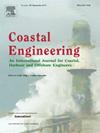墨西哥湾飓风波模拟的风强迫、源项和网格优化
IF 4.2
2区 工程技术
Q1 ENGINEERING, CIVIL
引用次数: 0
摘要
本研究评估了不同风强迫产品(ecmwf预报、ERA5、HRRR和哥白尼)驱动的WAVEWATCH III模式的性能,以及控制飓风Ida(2021)期间能量输入和耗散(ST4、ST6)和四重波波相互作用(离散相互作用近似- DIA、广义多重DIA - GMD)的模式源项的不同参数化行为。我们还比较了在均匀非结构化网格(30、20、10、3和1 km)和常规非均匀非结构化网格上配置的模型的性能。主要发现表明,ecmwf预报和HRRR在捕获相对于浮标、卫星和修订的大西洋飓风数据库(HURDAT2)观测的风速方面优于其他风强迫产品。然而,所有的风产品都倾向于低估20米/秒以上的风速,ECMWF和HRRR偶尔对35米/秒以上的风速值表现得更好。相应的波浪模拟结果表明,ECMWF和HRRR风产品的模式模拟可以更好地捕获Ida的波场,与墨西哥湾浮标的偏差分别为2%,与卫星数据的偏差分别为6%和3%。波浪模型源项对比结果表明,采用ST4-DIAs的模拟在体波分析中表现出优越的性能,计算效率高。使用三个四胞胎的ST4-GMD进行模拟比使用五个四胞胎的模拟效果更好,而使用ST6-DIA和ST6-GMD的模拟在批量度量中误差最大。我们还强调了通过计算模型和浮标之间某些选定源项的部分Hs和1D谱密度差异来进行体波分析的局限性。这揭示了在最低频率区(0.05-0.1 Hz)一致的高估和三个较高频率区(0.1-0.15;0.15 - 2;0.2-0.49 Hz),在不同频率上混合了负能量和正能量密度差异。具有最佳风调整参数的参数化ST4-DIA在HH、RMSE和偏置最低的三个高频箱中优于其他配置。最后,栅格对比结果显示,从30 km栅格到1 km栅格,Hs偏差减少了13%(超过4 m), 3 km栅格和1 km栅格的结果大致相似。具有95k个节点的传统非结构化网格的性能与具有186万个节点的1公里网格相当或略好。当风场不真实时,增加模式分辨率并不能减少波浪偏差,即使与观测值最一致的源项也不能补偿这些风的不确定性。本文章由计算机程序翻译,如有差异,请以英文原文为准。
Wind forcing, source term and grid optimization for hurricane wave modelling in the Gulf of Mexico
This study evaluates the performance of WAVEWATCH III model driven by different wind forcing products (ECMWF-forecast, ERA5, HRRR, and Copernicus), as well as the behavior of different parameterizations of the model's source terms controlling energy input and dissipation (ST4, ST6) and quadruplet wave-wave interactions (Discrete Interaction Approximation - DIA, Generalized Multiple DIA - GMD) during Hurricane Ida (2021). We also compare the performance of the model configured on uniform unstructured grids (30, 20, 10, 3, and 1 km) and conventional non-uniform unstructured grids. Key findings show that ECMWF-forecast and HRRR outperformed other wind forcing products in capturing wind speeds relative to buoys, satellite and the revised Atlantic hurricane database (HURDAT2) observations. However, all wind products tended to underestimate wind speeds above 20 m/s, with ECMWF and HRRR occasionally performing better for most wind speed values above 35 m/s relative to observations. The corresponding wave simulation results indicated that Ida's wave fields were better captured by model simulations with ECMWF and HRRR wind products, with biases of 2% against buoys in the Gulf of Mexico and 6% and 3% respectively against satellite data. The wave model source terms comparison results showed that simulations with ST4-DIAs exhibited superior performance in bulk wave analyses and were computationally efficient. Simulation using ST4-GMD with three quadruplets performed better than with five, while those with ST6-DIA and ST6-GMD showed the highest error in bulk metrics. We also highlighted limitations in bulk wave analysis by computing partial Hs and 1D spectra density differences between model and buoy for some selected source terms. This reveals consistent overestimation at the lowest frequency bin (0.05–0.1 Hz) and underestimation of the three higher frequency bins (0.1–0.15; 0.15–2; 0.2–0.49 Hz) with a mix of negative and positive energy density difference across different frequencies. The parameterization ST4-DIA with optimal wind adjustment parameter outperformed other configurations in the three high frequency bins having lowest HH, RMSE, and bias. Lastly, the grid comparison result showed a reduction in Hs bias from 30 km to 1 km grid configuration by up to 13% (over 4 m). The 3 km and 1 km grids generally showed similar results. Conventional unstructured grid with 95k nodes demonstrated comparable or slightly better performance than 1 km grid with 1.86 million nodes. Increasing model's resolution did not reduce wave biases when the wind field was misrepresented, and even the source term with the highest agreement with observations could not compensate for these wind uncertainties.
求助全文
通过发布文献求助,成功后即可免费获取论文全文。
去求助
来源期刊

Coastal Engineering
工程技术-工程:大洋
CiteScore
9.20
自引率
13.60%
发文量
0
审稿时长
3.5 months
期刊介绍:
Coastal Engineering is an international medium for coastal engineers and scientists. Combining practical applications with modern technological and scientific approaches, such as mathematical and numerical modelling, laboratory and field observations and experiments, it publishes fundamental studies as well as case studies on the following aspects of coastal, harbour and offshore engineering: waves, currents and sediment transport; coastal, estuarine and offshore morphology; technical and functional design of coastal and harbour structures; morphological and environmental impact of coastal, harbour and offshore structures.
 求助内容:
求助内容: 应助结果提醒方式:
应助结果提醒方式:


